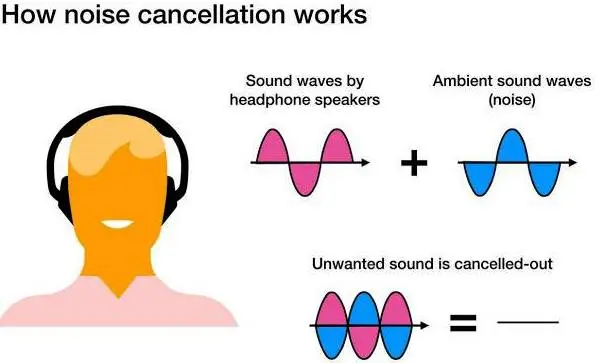How does Active Noise Cancelling Headphones work?
Noise-cancelling headphones work by using a combination of microphones and electronic processing to reduce or eliminate unwanted noise from the environment. Here’s how they work:
Microphone
Noise-cancelling headphones contain one or more microphones that pick up the sound from the environment.
Electronic Processing
The microphone signal is sent to electronic circuitry built into the headphones, which analyzes the incoming sound and generates a wave that is the exact opposite of the unwanted noise. This wave is called an “anti-noise” signal.
Anti-Noise Signal
The anti-noise signal is then played through the headphones’ speakers, effectively canceling out the unwanted noise in the environment.
User Experience
The resulting sound that the user hears is a combination of the original audio source and the anti-noise signal, but with the unwanted noise removed or greatly reduced.
This process is called active noise-cancellation because it actively works to cancel out unwanted noise in real-time. The headphones are designed to work best with continuous or low-frequency sounds, such as the hum of an airplane engine or the rumble of a train. The technology is less effective with sudden and high-pitched sounds, such as a car horn or a dog barking.
Noise-cancelling headphones are particularly useful in noisy environments, such as airplanes, trains, or busy offices, as they can reduce the amount of external noise and provide a more peaceful listening experience. They are also helpful for people who need to focus on their work or studies in noisy environments or for those who want to listen to music or audio content without being disturbed by external noise.
In summary, noise-cancelling headphones work by using microphones and electronic processing to generate an anti-noise signal that cancels out unwanted environmental noise, providing a more peaceful listening experience.
सक्रिय शोर रद्द करने वाला हेडफ़ोन कैसे काम करता है?
शोर-रद्द करने वाले हेडफ़ोन पर्यावरण से अवांछित शोर को कम करने या समाप्त करने के लिए माइक्रोफ़ोन और इलेक्ट्रॉनिक प्रसंस्करण के संयोजन का उपयोग करके काम करते हैं। यहां बताया गया है कि वे कैसे काम करते हैं:
माइक्रोफ़ोन
शोर-रद्द करने वाले हेडफ़ोन में एक या अधिक माइक्रोफ़ोन होते हैं जो पर्यावरण से ध्वनि उठाते हैं।
इलेक्ट्रॉनिक प्रसंस्करण
माइक्रोफ़ोन सिग्नल हेडफ़ोन में निर्मित इलेक्ट्रॉनिक सर्किटरी को भेजा जाता है, जो आने वाली ध्वनि का विश्लेषण करता है और एक तरंग उत्पन्न करता है जो अवांछित शोर के बिल्कुल विपरीत है। इस तरंग को “एंटी-शोर” सिग्नल कहा जाता है।
शोर-रोधी सिग्नल
फिर शोर-रोधी सिग्नल हेडफ़ोन के स्पीकर के माध्यम से चलाया जाता है, जो प्रभावी रूप से वातावरण में अवांछित शोर को रद्द कर देता है।
उपयोगकर्ता अनुभव
परिणामी ध्वनि जो उपयोगकर्ता सुनता है वह मूल ऑडियो स्रोत और शोर-विरोधी सिग्नल का संयोजन है, लेकिन अवांछित शोर को हटा दिया जाता है या बहुत कम कर दिया जाता है।
इस प्रक्रिया को सक्रिय शोर-रद्दीकरण कहा जाता है क्योंकि यह वास्तविक समय में अवांछित शोर को रद्द करने के लिए सक्रिय रूप से काम करता है। हेडफ़ोन को निरंतर या कम-आवृत्ति ध्वनियों, जैसे हवाई जहाज के इंजन की गड़गड़ाहट या ट्रेन की गड़गड़ाहट के साथ सबसे अच्छा काम करने के लिए डिज़ाइन किया गया है। अचानक और तेज़ आवाज़, जैसे कार का हॉर्न या कुत्ते का भौंकना, के मामले में यह तकनीक कम प्रभावी है।
शोर-रद्द करने वाले हेडफ़ोन हवाई जहाज, ट्रेन या व्यस्त कार्यालयों जैसे शोर वाले वातावरण में विशेष रूप से उपयोगी होते हैं, क्योंकि वे बाहरी शोर की मात्रा को कम कर सकते हैं और अधिक शांतिपूर्ण सुनने का अनुभव प्रदान कर सकते हैं। वे उन लोगों के लिए भी सहायक हैं जिन्हें शोर भरे वातावरण में अपने काम या पढ़ाई पर ध्यान केंद्रित करने की आवश्यकता है या जो बाहरी शोर से परेशान हुए बिना संगीत या ऑडियो सामग्री सुनना चाहते हैं।
संक्षेप में, शोर-रद्द करने वाले हेडफ़ोन एंटी-शोर सिग्नल उत्पन्न करने के लिए माइक्रोफ़ोन और इलेक्ट्रॉनिक प्रसंस्करण का उपयोग करके काम करते हैं जो अवांछित पर्यावरणीय शोर को रद्द कर देता है, और अधिक शांतिपूर्ण सुनने का अनुभव प्रदान करता है।




